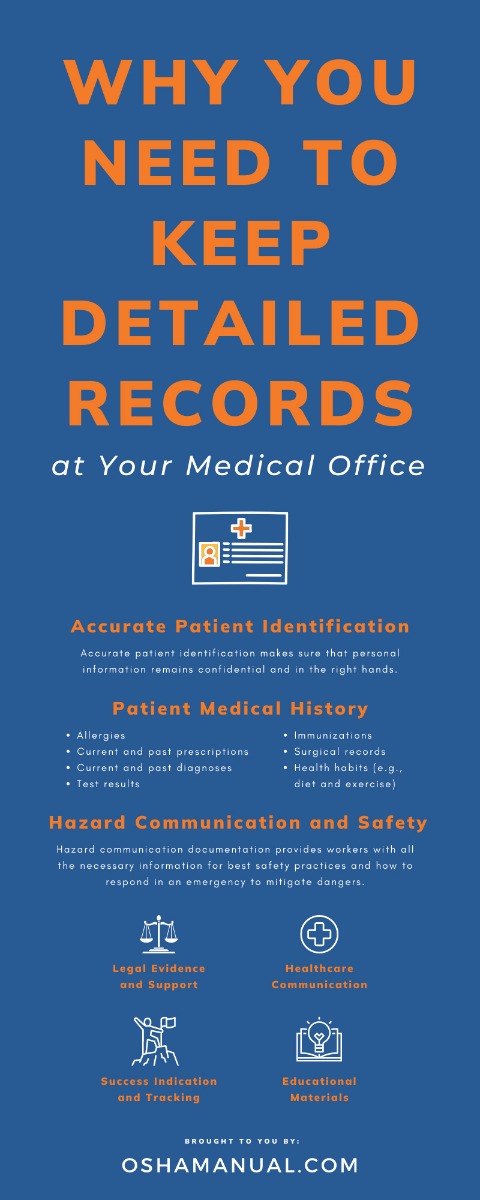
Medical professionals create, encounter, and handle a lot of information on a daily basis. The nature of their jobs exposes them to data that influences various aspects of a medical office’s operations, from patient care to employee work conditions and safety. Whether the information being handled is sensitive or for general use, documentation of all data is essential for success.
Recordkeeping is an effective and necessary procedure for any workplace. In some cases, certain recorded documents can even save lives. Learn why you need to keep detailed records at your medical office and improve your facility’s recordkeeping practices.
Accurate Patient Identification
Accurate patient identification makes sure that personal information remains confidential and in the right hands. Identification information also allows you to better organize and collect other pertinent patient information, helping you build a patient’s portfolio.
Keeping detailed records of each patient’s identity, like their physical descriptions, driver’s license numbers, and contact details, gives you plenty of resources to use to confirm patients’ identities. A lack of identification information can cause a lot of security risks. Without accurate and detailed identity data, you increase your chances of patient identity theft, fraud, and confidentiality breaches.
Patient Medical History
A patient’s medical history plays an important part in their future care. Common and important data found in a medical history profile includes:
- Allergies
- Current and past prescriptions
- Current and past diagnoses
- Test results
- Immunizations
- Surgical records
- Health habits (e.g., diet and exercise)
Information released in a patient’s history record gives current providers the necessary details to ascertain and provide optimal treatments and care. Knowing which prescriptions a patient is on helps medical professionals prescribe medications that won’t react with or affect current treatments. Allergy information also ensures doctors prescribe treatments that won’t endanger their patients or cause adverse reactions. Detailed records of each patient’s medical history can save lives, enhancing patient treatments and preventing health and safety issues.
Hazard Communication and Safety
OSHA’s hazard communication standards require medical offices to document hazardous chemicals apparent and used in their workplaces. The information provided on the hazardous substances should include important information such as identifiable physical attributes of the hazard, handling and storing requirements, and the dangers of the specific chemical.
Detailed records on workplace hazards reduce health and safety risks. Hazard communication documentation provides workers with all the necessary information for best safety practices and how to respond in an emergency to mitigate dangers. The more details about the hazard, the better-prepared people can be when faced with the hazard.
Legal Evidence and Support
Evidence is a critical component in legal cases. Any information that gives insight into the issue on hand can paint a more accurate picture of the situation and provide supporting data for one’s claims. Medical offices can face legal accusations because of the high-risk nature of their services— simply put, people’s lives are in their hands. In a lawsuit, any supportive evidence and documentation can save your business from extreme financial burdens.
Proper recordkeeping practices can help you build a case portfolio that provides essential information on those involved in the lawsuit, as well as other necessary details, from time frames to equipment involvement. If an employee gets injured on the job and the medical office provides documentation that they implemented all the best and necessary health and safety procedures, they can prove their innocence and avoid serious repercussions. Detailed documents are effective legal evidence and support.
Healthcare Communication
Medical offices work closely with other businesses, from insurance companies to other medical facilities. Detailed reports and documentation allow medical offices and their partners to communicate effectively with one another. A detailed report on a patient’s treatment allows their insurance company to determine how much money they owe the provider and what’s left for the patient to cover. Treatment documentation also gives referred providers essential details so they can properly perform treatment continuation.
Whether it’s for financial reasonings or cohesive treatment continuation, all parties involved should be on the same page and adequately informed so they can best carry out their parts. Detailed documentation maintains effective collaboration and coordination between businesses.
Educational Materials
Some forms of treatment work better than others. Certain procedures come with higher risks. Some illnesses are still being discovered. Every day, medical offices encounter different scenarios and collect important data that can help them develop educational materials for the future.
Documentation of any details of a rare illness provides critical research data. Recorded surgeries and treatments give aspiring medical professionals example materials and case studies to learn from. Documented workplace injuries offer offices insight into what went wrong and allow them to determine possible corrective actions to take in the future. Detailed documents and thorough recordkeeping help build a lot of beneficial educational resources.
Success Indication and Tracking
Growth is an indication of success. Whether it’s revenue or increasing patient retention rates, any form of growth signifies improvement and success. Keeping detailed documentation of business procedures and operations data throughout the years allows you to track your medical office’s progress. You can collect information that gives you some insight into what’s going well in your business. Tracking your progress gives you better management control over your business, allowing you to determine what processes are working and what needs to change.
Compliance Proof
OSHA and HIPAA compliance are mandatory requirements for medical offices. Both compliances ensure that best health and safety practices are in play. Detailed documentation provides your medical office with information that proves your business’s compliance and satisfies compliance requirements.
Many forms of documentation can secure your compliance. Some examples of essential compliance records include:
- Emergency action plans
- Hazard communication data
- Recorded injuries
- Past citations
- Training certifications
- Equipment lists and safety instructions
- Implemented security measures
Gaining OSHA and HIPAA compliance involves a lot of different steps. Keeping detailed documents is one of the many ways to achieve and maintain your mandatory obligations. Gamma Compliance Solutions’ HIPAA healthcare compliance training online also helps your office meet compliance requirements, as well as provides educational lessons on effective recordkeeping practices.
Keeping detailed records at your medical office offers many benefits. Information holds a lot of power in different situations. Maintaining and collecting an array of information related to your medical office ensures you always have the right resources to support your facility. Brush up on recordkeeping procedures with Gamma Compliance Solutions’ training manuals and enhance your medical office’s operations and work conditions.

